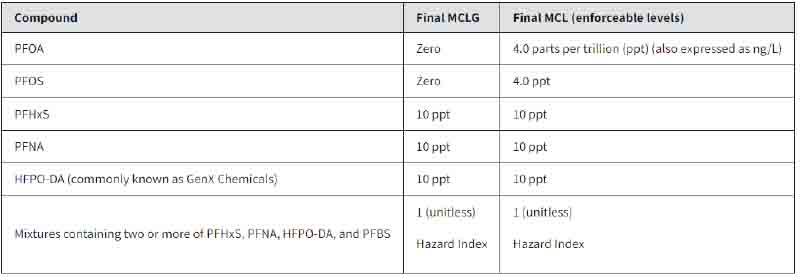What are PFAS?
- PFAS stands for Per- and Polyfluoroalkyl Substances, or commonly referred to as “Forever Chemicals”.
- PFAS are widely used, long lasting, manufactured chemicals commonly used in industry and consumer products since the 1940s.
- PFAS can be found in waste sites (near landfills, disposal sites, and hazardous waste sites), fire extinguishing foam, facilities (chrome plating, electronics, and manufacturers of certain textiles/papers), consumer products (stain/water repellent, non-stick products, paints, sealants, and some personal care products), food packaging (grease-resistant paper, microwave popcorn bags, pizza boxes, and candy wrappers), biosolids (fertilizer from wastewater treatment plants used on agricultural lands), and food (fish and dairy products from livestock that were exposed to PFAS).
What are the exposure effects of PFAS?
- Extended PFAS exposure has been associated with adverse health effects, such as reproductive complications, developmental delays in children, increased risk of some cancers, reduction in the body’s immune system capabilities, interference with hormones, and increased cholesterol levels.
Is there enforcement for PFAS levels?
- The EPA’s final rule for regulating PFAS became effective on June 25th, 2024.
- The final rule includes non-enforceable goals called Maximum Contaminant Level Goals (MCLGs) and enforceable Maximum Contaminant Levels (MCLs) for five individual PFAS chemicals and a mixture of PFAS chemicals called a Hazard Index (HI).
- Maximum Contaminant Level Goals (MCLGs): These are non-enforceable public health goals. MCLGs represent the maximum level of a contaminant in drinking water at which no known or anticipated adverse health effect would occur. They allow for a margin of safety and serve as targets for water systems to aim for in their treatment processes.
- Maximum Contaminant Levels (MCLs): These are enforceable standards that set the maximum permissible level of a contaminant in drinking water which can be delivered to consumers.
- Hazard Index (HI): The HI was established based on research showing that a combined mixture of some PFAS chemicals can have an additive effect, even if the individual chemicals are each present at lower levels.
- The following table is a summary of the MCLGs and MCLs for the five regulated PFAS chemicals and the HI:

- The Hazard Index is calculated using the following formula:

What is expected for Public Water Systems (PWSs)?
- Conduct initial and ongoing compliance monitoring for the regulated PFAS.
- Implement solutions to reduce regulated PFAS in their drinking water if levels violate the MCLs.
- Inform the public of the levels of regulated PFAS measured in their drinking water and if an MCL is exceeded.
What are the monitoring requirements?
- Initial monitoring requirements:
- Four quarterly samples within a 12-month period for groundwater systems serving greater than 10,000 people and all surface water systems.
- Two semi-annual samples within a 12-month period for groundwater systems serving less than 10,000 people.
- Use of recent, existing PFAS drinking water occurrence data is allowable for compliance monitoring.
Ongoing compliance monitoring:
- Based on “Rule Trigger Levels”, which is ½ of MCLs for regulated PFAS and Hazard Index
- See flow diagram below for ongoing compliance monitoring information:

How is compliance determined?
- Compliance is based on running annual averages (RAA) for systems conducting quarterly monitoring.
- Systems are out of compliance with National Primary Drinking Water Regulations (NPDWR) if the RAA of quarterly samples at a sampling point exceeds the respective MCL.
- A system will not be considered in violation of an MCL until it has completed one year of quarterly sampling.
What do I do if my system is out of compliance?
- PWSs are required to issue a public notice within 30 days of an MCL violation.
- Community water systems are required to include PFAS information in their annual Consumer Confidence Report (CCR).
How much time do I have?
- Initial monitoring must be complete within three years of the rule promulgation (2024-2027).
- Starting three years following rule promulgation (2027-2029):
- Results of initial and regular monitoring for compliance must be included in CCRs.
- PWSs must provide public notification for monitoring and testing violations.
- Starting five years following rule promulgation (2029), PWSs must:
- Comply with all MCLs and provide public notification for MCL violations.
How are PFAS removed?
- According to the EPA, the following treatment technologies were identified as the “Best Available Technologies” (BATs):
- Granular activated carbon,
- Ion exchange
- Reverse osmosis
- Nanofiltration
How can PWSs pay for treatment?
- Through the Bipartisan Infrastructure Law, approximately $9 billion is available for PFAS testing and treatment.
- These funds are expected to be routed through the State Revolving Fund (SRF) Emerging Contaminant (EC) program.
- In Texas, this funding is through the Texas Water Development Board (TWDB).
How Can JACOB | MARTIN Help?
Throughout our 75 years of existence, JACOB | MARTIN has assisted numerous communities and rural water supplies to secure funding through the Texas Water Development Board. We would love for your community to be next! Our teams possess extensive knowledge of the TWDB process, ensuring that your community can successfully navigate any project you choose.
To gain more insight on Texas Water Development Board funding, check out our previous blog post.
For more information, contact Kirt Harle, P.E., Senior Principal at (325) 695-1070, or your local JACOB | MARTIN representative.
